FSA Partnership Meetings:
March 3: Volusia County Partnership. Email Jennifer Winters.
March 4: Florida Keys Partnership. Email Suzy Roebling.
March 4: St. Johns/Flagler Partnership. Email Jean Olbert.
March 5: Space Coast Partnership. Email Anna Deyle.
March 9: Southeast Florida Partnership. Email Olivia Rothberg.
March 9: Collier Partnership. Email Collette Lauzau.
March 18: Lee/Charlotte Partnership. Email Tyson Dallas.
March 25: Suncoast Partnership. Email Holley Short.
Florida Shorebird Database (FSD) Training:
March 8, 1-2pm(EST): FSD webinar for new surveyors
March 9, 1-2pm(EST): FSD webinar for returning surveyors
March 10, 1-2pm(EST): FSD webinar for rooftop monitors
REGISTER HERE
The 2021 Shorebird Breeding Season is Here!
This newsletter is all about helping you prepare for shorebird conservation and monitoring during the 2021 breeding season. Your local partnership is organizing many activities, so please coordinate with them. The best way to do that is to attend a partnership meeting. If you can’t attend the meeting but would like to get involved, please contact shorebird@myfwc.com. Here are a few ways to get started:
Be a mentor, or team up with one. Does your partnership have new members? If so, encourage them to join a local bird steward program or bring them along on a monitoring survey. If you're a new member, check with your partnership for training and mentoring opportunities.
Get posting supplies. Do you have the posting supplies you need to cover your areas? Let your FWC regional shorebird contact know if you need signs (see our sign selection)
Get outreach materials. There are posters, brochures, coloring books, rooftop signs for businesses, etc. (see selection). Your FWC regional office may have them in stock.
Prepare for route surveys. If you have an assigned route, will you be able to survey it during all 6 count windows? If not, please find someone to fill in for you (or contact us for help). Remember to coordinate survey plans with your local partnership and register for a route or rooftop training webinar.
Prepare for roof monitoring. Can you help monitor rooftops with nesting birds? If so, coordinate with your partnership or contact us. Please let us know if roofs are no longer suitable for nesting (ex: building was torn down or re-roofed).
Read on for more details about getting involved this season...
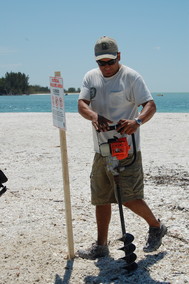
Posting Nest Sites
Posting is the process of installing signs and rope to create symbolic fencing around shorebird and seabird nesting habitat to protect breeding adults, nests, chicks, and brood-rearing activities. Posting is often the best tool to protect beach-nesting birds from human disturbance on popular beaches and islands. “Pre-posting” a section of the beach to give the birds an undisturbed place to initiate nesting is also a great tool, especially if you want to attract birds to a protected spot before they establish nests.
If you find a shorebird nest or seabird colony that has not yet been posted, please notify the local land manager or an FWC regional shorebird contact immediately so that it can be posted. Parks usually have their own preferred signs and posting materials, but if not (or if the nest is on private property), supplies and assistance can be requested by contacting your FWC regional shorebird biologist. Check out our sign selection – many can be printed off and laminated. Remember to seek landowner’s permission to post on private property.
The Florida Fish and Wildlife Conservation Commission recently published an updated edition of the Guidelines for Posting Shorebird and Seabird Sites in Florida. Previously updated in 2012, the new edition integrates best available science with best management practices used by wildlife managers to provide general methods for posting shorebird and seabird breeding habitat. Partners can view the new Posting Guidelines on the Resources section of the Florida Shorebird Alliance website.
|
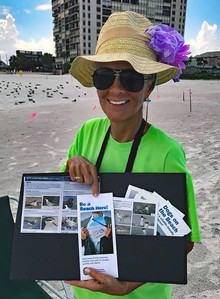
Bird Stewarding and Outreach
One of the greatest threats beach-nesting shorebirds face is disturbance from people, pets, and vehicles in the nesting area. Under these circumstances, signs posted around the nests are not enough to prevent people from disturbing nesting birds, and it requires time and effort from caring individuals, or beach stewards, to monitor the nests and chicks.
Shorebird steward programs are organized by shorebird partnerships throughout Florida. Where and when bird stewards will be needed is not fully determined until the birds have started nesting. This usually starts in March and can run into September, depending on the bird species. Stewarding begins after the nests and colonies are located and posted by biologists. Although the greatest needs for stewards is on weekends and holidays, stewarding can be done anytime an area has active shorebird nesting. While out on the beaches, stewards carry out two important tasks: 1) minimizing disturbance to the nests, and 2) informing the public about beach nesting birds.
To volunteer as a bird steward this season, please check this map to see if there is a steward program near you. If so, please call or email the program contact to get involved. If there is not a bird steward program near you, contact us about starting one. In addition to stewards, land managers and private citizens can also do a lot to educate others about beach-nesting birds. We have outreach materials to help you get the message out to beach drivers, photographers, and pedestrians on the beach.
photo: Ginger Goepper
|
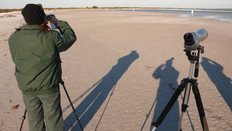
Breeding Bird Surveys and Training
Florida’s official shorebird monitoring program begins this month, with the first count window from March 18th – 24th. Everything you need to know to participate in the monitoring program can be found on the Florida Shorebird Database (FSD) website.
The website’s INSTRUCTIONS tab details what the monitoring program involves. The RESOURCES page contains videos on data entry and the Breeding Bird Protocol (BBP), which explains the monitoring process and includes data sheets.
All volunteers are encouraged to register for a training webinar. The March 8th webinar is for new volunteers who plan to survey a specific route (usually along the beach). The March 9th webinar is for returning volunteers and includes updates to the BBP and FSD interface. The March 10th webinar is for volunteers who plan to monitor rooftops and focuses the rooftop section of the BBP and FSD interface .
All webinars are from 1-2pm Eastern.
Details and instructions will be emailed to registered participants prior to the webinars.
Register here for the 2021 webinars.
|
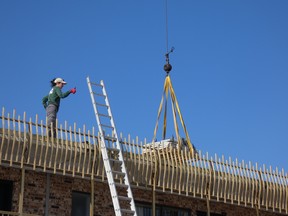
Rooftop Monitoring and Outreach
Many seabirds and shorebirds nest on gravel rooftops in Florida, making rooftop monitoring and outreach important components of our work. There are hundreds of rooftops throughout the state where seabirds have historically nested, and we need your help monitoring them. If you are willing to check on a nearby rooftop, please contact your local partnership to learn where you can assist. If you would like to become a monthly rooftop monitor, March - August, please review the rooftop section of the Breeding Bird Protocol.
If you see shorebirds or seabirds flying to or from a rooftop, the birds are likely nesting on that roof. It is important to talk to the property owners or managers, to help make them aware of the protected species nesting on their roof. The building’s residents or employees can alert you if there are falling chicks or other issues, so it’s important to talk to them early in the season and leave a phone number they can call. We have signs, letters, postcards, and other Rooftop Resources to help you with outreach.
At rooftops where birds nest every year, there may be things you can do to prepare for the upcoming season. First, please remind the property owner to schedule rooftop repairs or air conditioning maintenance the month before the birds arrive. Also, some partnerships are “chick-proofing” rooftops, so please contact your local partnership to see if they need help.
If you see chicks falling off the roof, they should be returned to the rooftop as soon as possible. Please consult the Chick-Checking Manual for further instructions.
photo: Bonnie Samuelsen
|

The Florida Shorebird Database is Open for the Season!
The breeding season is here and the first Breeding Bird Protocol Count Window is March 18-24. Before entering your breeding data, you may want to do a little spring cleaning of your Florida Shorebird Database (FSD) account:
- Review the 2021 Breeding Bird Protocol. We clarified some of the explanations for the Count Types, so be sure to check it out!
-
Log in to your FSD account.
- Make sure your contact information, data entry permissions, and partnership affiliations are up-to-date by clicking Manage Account.
- Review your list of routes and rooftops.
- Are you still planning to survey the routes and rooftops listed in your profile? If not, you may want to remove them from your profile.
- Are the routes and rooftops in the correct location? If not, email FLShorebirdDatabase@myFWC.com to update their locations.
- Are the descriptions for the routes and rooftops accurate? If not, you can update the information by clicking ‘View/Edit’, then editing the Description.
- Are the routes and rooftops still suitable for nesting? If not, email FLShorebirdDatabase@myFWC.com to retire them.
Thank you for your dedication to shorebird and seabird conservation. May the 2021 nesting season be highly productive!
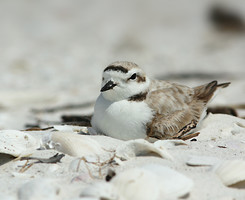
First Documented Nest of 2021
The 2021 breeding season officially arrived with the first documented shorebird nest. On February 22nd FWC Shorebird Biologist, Ezra Thompson, and Audubon Florida Shorebird Biologist, Michael Ferrara, discovered a snowy plover nest in the eastern panhandle. Snowy plovers are consistently the earliest nesting shorebirds in Florida. The earliest recorded snowy plover nest was documented on February 14th in 2017!
|
|